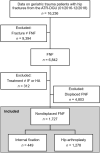Internal fixation versus hip arthroplasty in patients with nondisplaced femoral neck fractures: short-term results from a geriatric trauma registry
- PMID: 34609521
- PMCID: PMC9192444
- DOI: 10.1007/s00068-021-01801-1
Internal fixation versus hip arthroplasty in patients with nondisplaced femoral neck fractures: short-term results from a geriatric trauma registry
Abstract
Purpose: To determine whether internal fixation (IF) or hip arthroplasty (HA) is associated with superior outcomes in geriatric nondisplaced femoral neck fracture (FNF) patients.
Methods: Data from the Registry for Geriatric Trauma of the German Trauma Society (ATR-DGU) were analyzed (IF Group 449 and HA Group 1278 patients). In-hospital care and a 120-day postoperative follow-up were conducted. Primary outcomes, including mobility, residential status, reoperation rate, and a generic health status measure (EQ-5D score), and the secondary outcome of mortality were compared between groups. Multivariable analyses were performed to assess independent treatment group associations (odds ratios, ORs) with the primary and secondary end points.
Results: Patients in the HA group were older (83 vs. 81 years, p < 0.001) and scored higher on the Identification of Seniors at Risk screening (3 vs. 2, p < 0.001). We observed no differences in residential status, reoperation rate, EQ-5D score, or mortality between groups. After adjusting for key covariates, including prefracture ambulatory capacity, the mobility of patients in the HA group was more frequently impaired at the 120-day follow-up (OR 2.28, 95% confidence interval = 1.11-4.74).
Conclusion: Treatment with HA compared to treatment with IF led to a more than twofold increase in the adjusted odds of impaired ambulation at the short-term follow-up, while no significant associations with residential status, reoperation rate, EQ-5D index score, or mortality were observed. Thus, IF for geriatric nondisplaced FNFs was associated with superior mobility 120 days after surgery. However, before definitive treatment recommendations can be made, prospective, randomized, long-term studies must be performed to confirm our findings.
Keywords: Elderly; Health-related quality of life; Hip fracture; Mobility; Reoperation; Treatment.
© 2021. The Author(s).
Conflict of interest statement
The authors report no conflict of interest in this work.
Figures


References
MeSH terms
LinkOut - more resources
Full Text Sources
Medical
Miscellaneous

